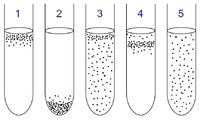
Photo from wikipedia
Glucose and xylose are the two most abundant sugars derived from the breakdown of lignocellulosic biomass. While aerobic glucose metabolism is relatively well understood in E. coli, until now there… Click to show full abstract
Glucose and xylose are the two most abundant sugars derived from the breakdown of lignocellulosic biomass. While aerobic glucose metabolism is relatively well understood in E. coli, until now there have been only a handful of studies focused on anaerobic glucose metabolism and no 13C-flux studies on xylose metabolism. In the absence of experimentally validated flux maps, constraint-based approaches such as MOMA and RELATCH cannot be used to guide new metabolic engineering designs. In this work, we have addressed this critical gap in current understanding by performing comprehensive characterizations of glucose and xylose metabolism under aerobic and anaerobic conditions, using recent state-of-the-art techniques in 13C metabolic flux analysis (13C-MFA). Specifically, we quantified precise metabolic fluxes for each condition by performing parallel labeling experiments and analyzing the data through integrated 13C-MFA using the optimal tracers [1,2-13C]glucose, [1,6-13C]glucose, [1,2-13C]xylose and [5-13C]xylose. We also quantified changes in biomass composition and confirmed turnover of macromolecules by applying [U-13C]glucose and [U-13C]xylose tracers. We demonstrated that under anaerobic growth conditions there is significant turnover of lipids and that a significant portion of CO2 originates from biomass turnover. Using knockout strains, we also demonstrated that β-oxidation is critical for anaerobic growth on xylose. Quantitative analysis of co-factor balances (NADH/FADH2, NADPH, and ATP) for different growth conditions provided new insights regarding the interplay of energy and redox metabolism and the impact on E. coli cell physiology.
Journal Title: Metabolic engineering
Year Published: 2017
Link to full text (if available)
Share on Social Media: Sign Up to like & get
recommendations!